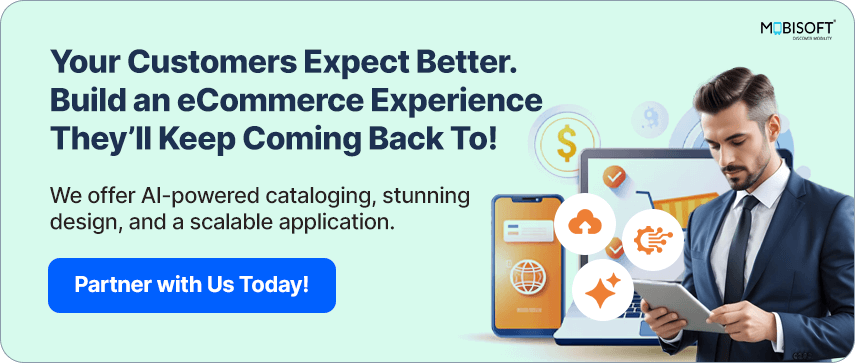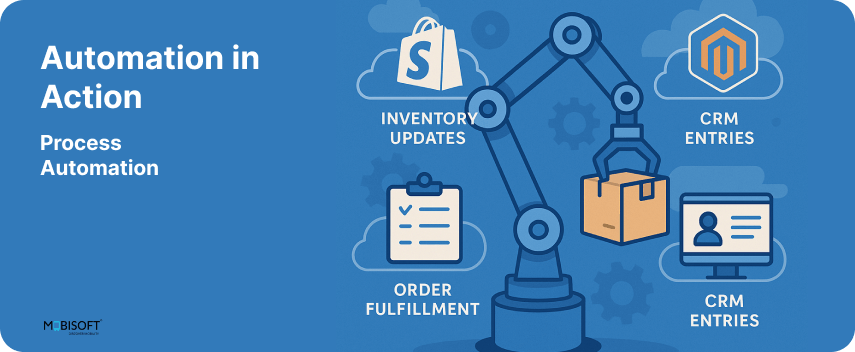Online shopping is growing fast, and if your business runs on spreadsheets and disconnected tools, you’re wasting time, money, and opportunities. Orders stack up. Inventory gets messy. Customers expect seamless service. Manual processes can’t keep up. It is here that implementing an ERP system for ecommerce businesses can work wonders. It automates processes, gives you useful information, improves customer communication, and makes you ready for success in the long run.
If you're looking to future-proof your digital storefront, explore our comprehensive e-commerce development services that align with your ERP goals.
Why Must You Streamline E-commerce Operations with ERP?
E-commerce companies conduct numerous activities, such as order processing, inventory management, customer service, and finance operations. Growing your business should not create more problems. Your sales, inventory, and finances often sit in different systems. This separation wastes time. You keep fixing mistakes that could be avoided. Ecommerce ERP integration solves this. It automates your workflows. Your business runs smoother. You scale faster. You stop doing repetitive busywork.
What Is Ecommerce ERP Integration and Why Does It Matter?
Ecommerce ERP Integration is the act of integrating your online shop, like Shopify, Magento, or WooCommerce, into an ERP system. This integration causes the two systems to share information automatically, with orders, stock, customer data, finances, and much more in real-time data sync ERP e-commerce.
Our expertise in developing e-commerce stores with custom ERP integration can help you streamline these processes from day one.
Compared to the tedious task of making changes in numerous locations one at a time, integration via ERP has all departments' sales, fulfillment, and finance viewing the same current information, enabling centralized e-commerce operations.
Source: What is ERP Integration? (Deepstream Guide)

Top Benefits of ERP in E-commerce Businesses
Increased Efficiency and Productivity
Automation of Routine Tasks
Order picking, stocking, invoicing, and shipping are all automated, saving labor and allowing employees to be released for strategic initiatives.
Elimination of Data Silos
All business data feeds into one central system, making all teams see the same information and eliminating the possibility of errors through ERP and inventory management.
Real-Time Data Sync and Visibility
Centralized Dashboard
Decision makers have a complete real-time picture of operations, from sales performance to supply chain status, enabled by cloud based ERP solutions.
Faster, Smarter Decisions
Accessibility to accurate, up-to-date information enables effective anticipation, improved forecasting, and rapid response to change in the marketplace.
Enhanced Customer Experience
Accurate Inventory and Orders
Customers view actual levels of stock available, minimizing the risk of stockout or overstocking.
Automated Communication
Automated order confirmations, shipping notifications, and tracking information make customers happy and informed.
Modified Support
The data supports targeted advertising and customized services, thus fostering loyalty and repeated usage.
Accurate Inventory and Order Management
Real-Time Inventory Tracking
ERP integration with ecommerce provides end-to-end visibility of inventory levels across all channels and warehouses, enabling just-in-time inventory management.
Efficient Order Fulfillment
They are made available on the internet in the ERP system, affecting smooth fulfillment, invoicing, and shipping, with fewer chances for delay and mistake.
Cost Savings and Scalability
Reduced Operational Costs
Higher productivity and automation advantages reduce the cost of labor, reduce the chances of human mistakes, and increase the use of resources.
Scalability
These scalable ERP systems for e-commerce are built to expand with your enterprise, enabling you to pursue new geographies, markets, and product markets without experiencing operational constraints.
Source: Benefits of ERP for E-commerce Businesses (Elsner)
How ERP Integration Works: Core Processes

Order Synchronization
Orders on the e-commerce site automatically flow into the ERP for processing, invoicing, and fulfillment.
Inventory Updates
Inventory levels are updated in real time across all platforms, preventing overselling and stockouts.
Customer Data Management
Customer information is compiled to enable 360-degree views for support and marketing.
Accounting and Financials
Automatically, payments, returns, and sales are recorded, and reporting and reconciliation are easy.
Supply Chain Coordination
Buying, shipping, and handling suppliers are made more accessible, making the process simpler and delivery faster.
ERP Implementation for Online Businesses: Best Practices and Strategies

Develop a Robust Integration Strategy
Align integration goals with business goals and identify key data flows to ensure a successful ERP implementation for online businesses.
Choose the Right Integration Method
They may be APIs, middleware, native connectors, or custom; select according to your technical requirements and scalability needs.
Prioritize Real-Time Data Sync
Ensure inventory, orders, and customer information are consistently updated to support real-time data sync ERP e-commerce operations.
Engage All Stakeholders
Involve operations, IT, finance, and sales teams to meet all business needs and create a comprehensive ecommerce ERP Integration strategy.
Adopt a Phased Implementation
Start with high-priority tasks, verify all thoroughly, and advance integration gradually to minimize issues.
Train Your Team
Ensure staff are well-trained to use new systems effectively. This builds long-term success with your ERP software for online stores.
Monitor and Optimize
Track performance continuously and make improvements to maximize the impact of your ERP and CRM integration for e-commerce.
Source: ERP and E-commerce Integration: A Quick Guide (DCKAP)
Successful Ecommerce ERP Integration: Use Cases and Insights
Many companies have achieved breakthrough results through backend system unification. For example, a leading fashion brand scaled globally through a tailored ERP integration. You can read the full case study on ecommerce transformation through backend integration to understand their journey.
Gymshark (Shopify Plus + ERP Integration)
- Challenge: Rapid growth led to complex supply chain and inventory challenges.
- Solution: Integrated Shopify Plus with ERP, automating inventory updates, order processing, and business analytics using a scalable ERP integration for e-commerce model.
- Result: Streamlined operations, improved inventory management, and enhanced customer experience
Bernardo 1946 (Shopify + SAP B1)
- Challenge: Manual order processing and inventory inaccuracies.
- Solution: Automated data flow between Shopify and SAP B1 ERP.
- Result: Reduced manual errors, improved operational efficiency, and real-time synchronization of orders and inventory.
Company C (E-commerce Excellence with ERP)
- Challenge: Manual order processing and a lack of real-time inventory data.
- Solution: Implemented a pre-configured ERP system with minimal customization.
- Result: Order processing time reduced by 25%, inventory issues cut by 20%, and online sales increased by 15%.
Source: ERP Implementation Case Studies (ERP Focus)
Solving Common Ecommerce ERP Integration Challenges

Implementing ERP brings more than just integration; it provides valuable insights that fuel growth. Companies looking to drive deeper insight from their systems should consider strategies to boost ecommerce analytics with ERP integration early in their journey.
| Challenge | Solution |
| Data Compatibility | Use standardized data formats and robust mapping tools for ERP and inventory management. |
| Implementation Costs | Plan budgets carefully, select scalable ERP systems for e-commerce, and avoid customization. |
| Process Alignment | Reengineer workflows to match ERP best practices. |
| Change Management | Invest in staff training and open communication. |
| Ongoing Maintenance | Review and update the integration periodically as business needs evolve. |
Source: Overcoming ERP Integration Challenges (Spinnaker Support)
ERP for E-commerce: FAQs
Q: What is the prime benefit of ERP e-commerce integration?
A: It streamlines and automates business processes, reducing errors, manual handling, and operating expenses while boosting efficiency and customer satisfaction.
Q: How does ERP integration improve customer experience?
A: Customers can enjoy real-time stock availability, quicker order processing, guaranteed tracking, and customized communication.
Q: Is ERP integration only for large businesses?
A: No, contemporary ERP systems and integration platforms are just as scalable and available to businesses of all sizes, including SMEs
Q: What’s the best way to start ERP integration?
A: Review current processes, engage stakeholders, choose an integration method that aligns with your needs, and phase adoption to facilitate adoption.
Source: ERP Integration FAQs (Adeptia)
Conclusion: Streamline, Scale, and Succeed with Ecommerce ERP Integration
The integration of ERP on your website efficiently changes your business through automation that ensures efficiency and long-term growth. Through the streamlining of key operations, information organization, and more openness, your business becomes nimble, enabling it to respond quickly to market needs, deliver an improved customer experience, and accept more growth.
Thinking of going deeper? Our team specializes in building ERP integrated ecommerce applications to help you gain a competitive edge.
Also, don’t forget to track ecommerce KPIs with centralized ERP data to ensure consistent growth.
Will you be implementing ERP on your online business?
Get expert advice and tailored ERP for e-commerce automation solutions from Mobisoft Infotech.
ERP & E-commerce Integration References:
- Ecommerce ERP integration boosts business productivity
- How ERP-E-commerce Integration Elevates Business Performance - Blog
- A Guide to ERP and Ecommerce
- ERP Ecommerce Integration: Best Practices for ERP System Integration | EPAM Startups & SMBs
- eCommerce Order Processing Automation using ERP Integration
- The 7 Ways an Ecommerce and ERP Integration Will Help Unlock Your Competitive Edge | Experlogix
- 3 Successful ERP Implementation Case Studies | NetSuite
- Revolutionary Impact of ERP on Ecommerce Success
- 3 successful ERP implementation case studies to learn from
- ERP & eCommerce Integration: 5 Must-Answer Questions for Success - Ultra Commerce
- Common ERP Integration Challenges and How to Avoid Them - Spinnaker Support
- 40 questions you must ask when integrating eCommerce to ERP Alumio Checklist
- 10 Benefits Of ERP For ECommerce Businesses | Rixxo
- Maximizing E-commerce Success: The Roles and Benefits of ERP Systems
- Ecommerce ERP Integration Guide - 2024 | Jitterbit
- 5 SAP Integration Case Studies And Remarkable Results With APPSeCONNECT
- Unlocking Success: Real-World ERP Systems Examples and Lessons Learned
- LOGIC ERP Case study | Implementation Success Stories
- ERP-Integrated E-Commerce: What It Is, Benefits & Resources
- https://www.deep.stream/guides/what-is-erp-integration
- What Is ERP eCommerce Integration? [+Best Practices]
- How Ecommerce ERPs Streamline Operations + Boost Growth
- The Essential Guide to Integrating E-commerce with ERP Systems
- E-commerce Integrations Case Study - The Man Company
- ERP Integration FAQs about ERP data and system integration
- E-commerce ERP: Integrate your entire business
- ERP E-commerce Integration: The Ultimate Guide - NOI Technologies LLC | Moqui & Apache OFBiz ERP Solutions and Web Development Experts
- ERP Integrations: Common Patterns and Methods + Best Practices
- ERP Integration: Definition, Types, Advantages, and Best Practices
- eCommerce Case Studies - ERP Failure Customer Stories
- Kensium Case Studies: Success Stories for E-Commerce and ERP Integration
- Case Study 08: ERP and eCommerce Integration
- 16 Frequently Asked Questions About ERP
- 5 Common ERP Integration Questions, Answered | AdRoll
- 5 Common ERP Questions | Datix





 June 26, 2025
June 26, 2025


